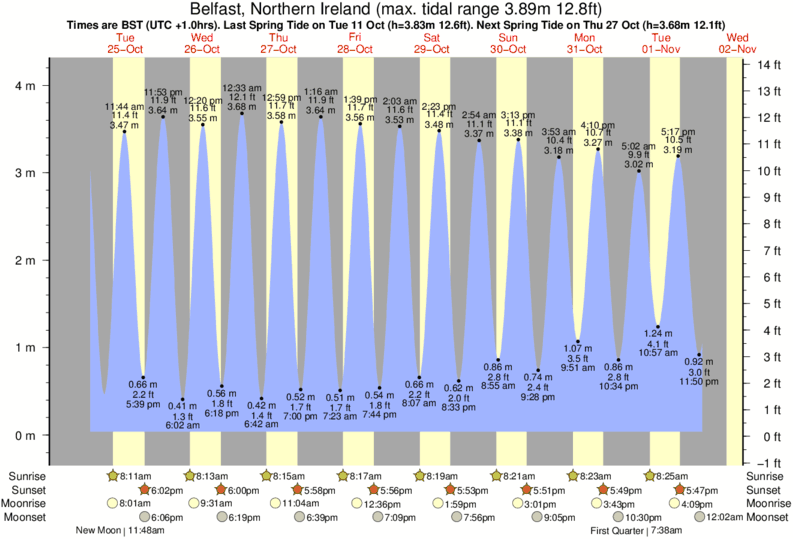
The flow and ebb are gradual, so it is not accurate to say that a high or low tide lasts around 6 hours and 12 minutes, i.e. The technical term for the difference in water level between high tide and low tide is tidal range.

The change from low to high tide is known as flood tide, while the change from high to low tide is called ebb tide. On the other hand, the tidal lag in the North Sea-a part of the Atlantic Ocean bounded by continental Europe and the British Isles-can be about two days. In the Southern Ocean, where tidal bulges can move relatively freely, the tidal lag may be around two hours. The time that passes between the passage of the Moon and the onset of the high tide is called the tidal lag. While in theory, the tidal bulges follow the Moon's position on its orbit around the Earth, the depth and shape of the ocean and the distance between continents are also important in determining when the tide rolls in and out. This tidal cycle is called a diurnal cycle, as opposed to the normal semidiurnal cycle, where diurnal means daily and semi means half. Along the coastline of the Gulf of Mexico, there is only one tide per day due to the local shoreline topography, among other things. It takes half a lunar day, on average 12 hours and 25 minutes, from one high tide to the next, so we have high and low tides nearly twice a day.Īccording to the National Ocean Service, there are some exceptions to the main rule of two tides every lunar day. The reason the lunar day is longer than a solar day is that the Moon revolves around Earth in the same direction as Earth rotates around its axis, so it takes Earth, on average, an additional 50 minutes to “catch up” to the Moon.īecause the tidal force of the Moon is more than twice as strong as the Sun's, the tides follow the lunar day, not the solar day. However, the time it takes Earth to reach the same position in relation to the Moon is, on average, 24 hours and 50 minutes, known as a lunar day. This is known as a solar day, and it lasts around 24 hours. So, why is that?Ī day on Earth is the time it takes our planet to spin once around its own axis in relation to the Sun. Tides are one of the most reliable phenomena in the world, and we know that they move in and out around twice a day, but not exactly. In some places, the water flows freely and quickly, while in other areas, where the water has to pass through narrow channels, it moves more slowly. As a result, the tides behave more like water sloshing around in an oddly shaped bathtub than in a smooth and even basin. This is because the water in the oceans is constrained by the shape and distance between the continents as well as varying ocean depths. It can range from almost no difference to over 16 meters (over 50 feet). However, the variation between high and low tide is very different from place to place. Mid-ocean, each tidal “wave” is just under a meter high, compared to the water level of the two troughs between them. Due to Earth's rotation, the two bulges act like two expansive “waves” continuously undulating around our planet. The overall effect of these tidal forces is to “squeeze” the oceans, and produce two tidal bulges on opposite sides of the Earth-one facing the Moon and a slightly smaller one facing away from the Moon (see illustration).

The Sun's gravitational force, on the other hand, varies much less because the Sun is so far away. The tidal forces of the Moon are much stronger than the Sun's because it is so much closer to our planet, causing a much greater variation in the gravitational force from one location to another. This variation creates the differential forces or tidal forces that in turn cause tides. Rather, tides are created because the strength and direction of the gravitational pull varies depending on where on Earth you are. This is because, contrary to common belief, tides are not caused by the gravitational forces of the Moon or the Sun lifting up the oceans-their gravitational pull is much too weak for that. Although the Sun's gravitational pull on the Earth is 178 times stronger than the Moon's, the tidal bulges it causes are much smaller. While both the Moon and the Sun influence the ocean tides, the Moon plays the biggest role. Business Date to Date (exclude holidays).


 0 kommentar(er)
0 kommentar(er)
